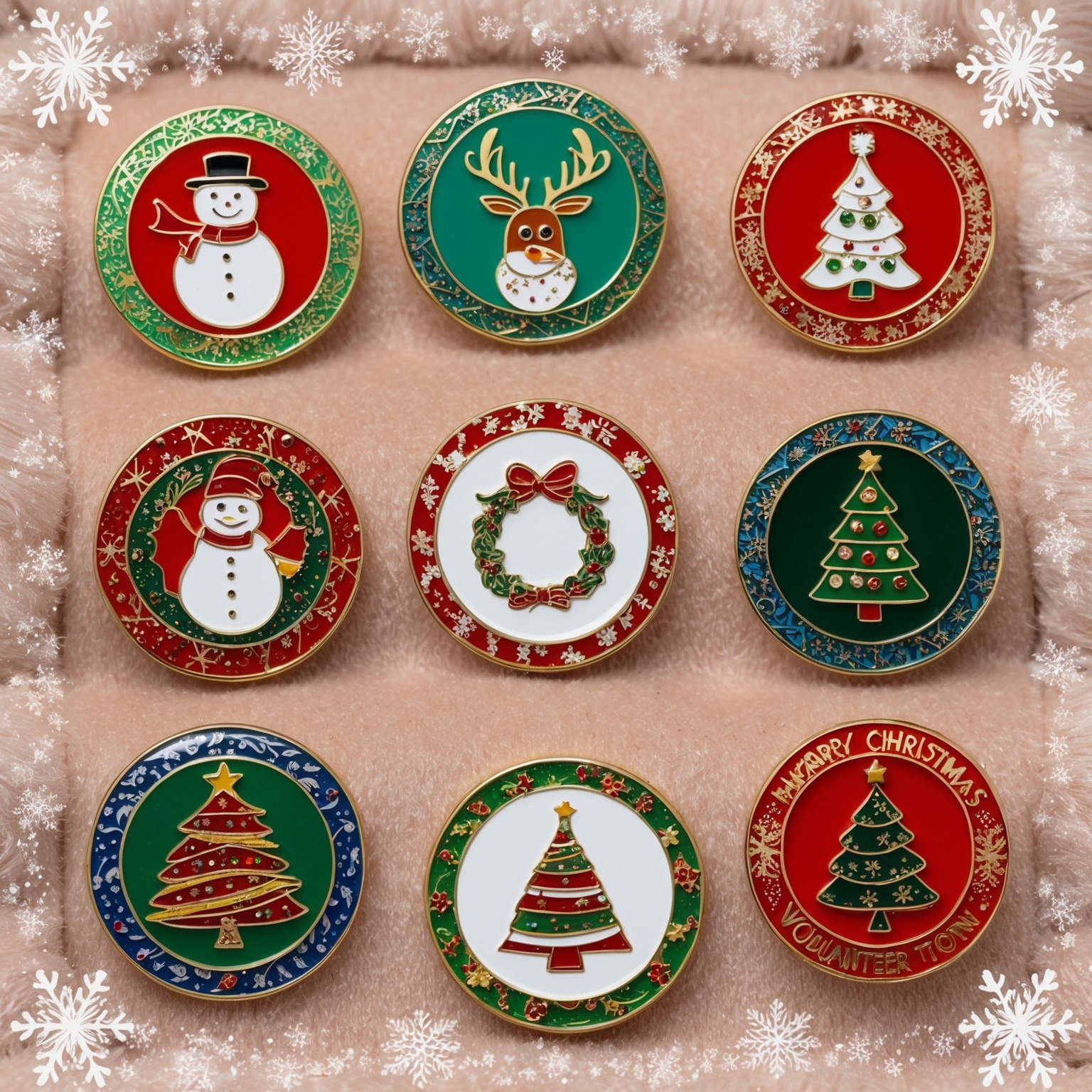Trading pins are not just colorful pieces of metal; they are cherished collectibles that represent memories, achievements, and passions. Whether you’re an avid collector of sports pins, Disney pins, or other themed pins, preserving the value of your trading pin collection is essential. Over time, these pins can become more valuable, but only if they are kept in excellent condition. Preserving the mint condition of your trading pins requires careful attention to storage, handling, and display.
In this comprehensive guide, we’ll explore nine strategies to help you maintain the value of your trading pin collection. By following these tips, you can ensure that your pins remain in pristine condition, retaining their beauty and value for years to come.
1. Store Pins in a Climate-Controlled Environment
One of the most important factors in preserving your trading pin collection is storing it in a climate-controlled environment. Extreme temperatures and humidity can cause pins to tarnish, corrode, or lose their luster over time.
Avoiding Temperature Extremes
Trading pins are typically made of metal, which can expand and contract with temperature fluctuations. This can lead to warping, cracking, or damage to the enamel finish. To prevent this, store your pins in a location where the temperature remains stable, ideally between 60 and 75 degrees Fahrenheit. Avoid attics, basements, or garages, where temperatures can vary widely.
Controlling Humidity Levels
High humidity can cause metal pins to rust or tarnish, especially if they are not properly protected. Aim to keep the humidity level in your storage area between 40% and 50%. You can use a dehumidifier in the room where you store your pins or place silica gel packets in your storage containers to absorb excess moisture.
2. Handle Pins with Care
Handling your trading pins with care is crucial to maintaining their condition. Oils, dirt, and moisture from your hands can damage the pins over time, leading to discoloration or corrosion.
Use Clean Hands or Gloves
Always wash your hands thoroughly before handling your pins. Better yet, consider wearing cotton gloves to prevent oils and dirt from coming into contact with the pins. Gloves also help protect the pins from accidental scratches caused by fingernails or rings.
Avoid Excessive Handling
While it’s tempting to admire your pins frequently, excessive handling can increase the risk of damage. Try to limit how often you handle your pins, and when you do, hold them by the edges rather than the front or back surfaces. This reduces the chance of leaving fingerprints or smudges on the pin’s surface.
3. Protect Pins from Light Exposure
Exposure to direct sunlight or harsh artificial lighting can cause the colors on your trading pins to fade over time. This is particularly true for pins with bright enamel finishes or intricate designs.
Store Pins in a Dark Place
To protect your pins from light damage, store them in a dark place, such as a drawer, cabinet, or covered box. If you prefer to display your pins, make sure they are not exposed to direct sunlight. Consider using UV-protective glass or acrylic in display cases to filter out harmful UV rays.
Rotate Displays
If you have a large collection of trading pins, consider rotating which pins are on display. This ensures that individual pins are not exposed to light for extended periods, reducing the risk of fading.
4. Use Proper Storage Solutions
Choosing the right storage solution for your trading pins is essential to keeping them in mint condition. Proper storage protects pins from dust, dirt, and physical damage while keeping them organized and easily accessible.
Pin Bags and Cases
Pin bags and cases are popular storage options for trading pin collectors. These specially designed bags come with soft, padded pages that allow you to securely attach your pins without damaging them. The pages often have clear plastic covers, making it easy to view your collection while keeping the pins protected.
Display Frames and Cases
If you prefer to showcase your trading pins, consider using display frames or cases that are specifically designed for pins. These cases typically feature soft backing material that allows you to securely pin your collection in place. Look for cases with UV-protective glass or acrylic to shield your pins from light exposure.
Acid-Free Storage Containers
For long-term storage, consider using acid-free storage containers or archival-quality boxes. Acid-free materials prevent the pins from coming into contact with harmful chemicals that can cause discoloration or corrosion. Line the bottom of the containers with soft, acid-free tissue paper to provide extra cushioning for your pins.
5. Regularly Clean Your Pins
Regular cleaning is essential to maintaining the appearance and value of your trading pins. However, it’s important to clean your pins carefully to avoid causing damage.
Gentle Cleaning Techniques
Use a soft, lint-free cloth to gently wipe the surface of your pins. For more stubborn dirt or fingerprints, dampen the cloth with a small amount of distilled water and gently clean the affected area. Avoid using tap water, as it may contain minerals or chemicals that can damage the enamel or metal.
Avoid Harsh Chemicals
Never use harsh chemicals, abrasive cleaners, or metal polish on your trading pins, as these can damage the enamel, plating, or finish. If your pins require a deeper clean, consider using a mild soap solution (a few drops of dish soap in distilled water) and gently wiping the pins with a soft cloth. Be sure to thoroughly dry the pins afterward to prevent moisture-related damage.
Cleaning Antique or Vintage Pins
If you have antique or vintage trading pins, it’s best to avoid cleaning them yourself. These pins may be more delicate and prone to damage from improper cleaning techniques. Instead, consult a professional conservator who specializes in metalwork or collectibles.
6. Keep Pins Organized and Cataloged
Keeping your trading pin collection organized and cataloged not only makes it easier to find specific pins but also helps you monitor their condition over time. An organized collection is also more appealing to potential buyers or traders.
Organize by Theme or Series
Consider organizing your trading pins by theme, series, or collection. For example, you might group sports pins by team or event, Disney pins by character or movie, or Olympic pins by year or host city. This not only makes it easier to locate specific pins but also creates a visually pleasing display.
Create a Catalog or Inventory
Maintain a catalog or inventory of your trading pin collection. This can be a simple spreadsheet that lists each pin, its description, condition, and any relevant information such as the year of issue or where it was acquired. An inventory helps you keep track of your collection’s value and condition, and it can be useful for insurance purposes.
Take Photographs
Photograph each pin in your collection as part of your cataloging process. High-quality images can be helpful for identifying pins, documenting their condition, and sharing your collection with others. Be sure to store the images in a secure digital format, with backups in case of data loss.
7. Protect Pins During Transport
Transporting your trading pins to events, shows, or trading meets can put them at risk of damage. Proper precautions are necessary to ensure that your pins remain in mint condition during travel.
Use Protective Cases
Invest in a high-quality protective case specifically designed for transporting pins. These cases often feature padded interiors, individual compartments, and secure closures to keep your pins safe. Avoid using loose bags or containers that allow the pins to move around, as this can lead to scratches or other damage.
Wrap Pins Individually
If you’re transporting valuable or fragile pins, consider wrapping each pin individually in soft, acid-free tissue paper or bubble wrap. This adds an extra layer of protection against scratches, dings, or other physical damage during transport.
Keep Pins Secure
When traveling with your pins, keep them in a secure location, such as a carry-on bag or a padded case that stays with you at all times. Avoid checking your pins in luggage, as this increases the risk of loss, theft, or damage during transit.
8. Monitor and Maintain Pin Backs
The backs of trading pins are just as important as the fronts when it comes to preserving value. Damaged or missing pin backs can affect the overall condition and value of your collection.
Regularly Check Pin Backs
Periodically inspect the backs of your trading pins to ensure that the pin posts are straight and intact, and that the pin backs are secure. Bent or damaged posts can lead to loose or wobbly pins, which are more prone to falling off or getting lost.
Replace Worn or Damaged Pin Backs
If you notice that a pin back is worn, damaged, or no longer securely holds the pin in place, replace it with a new one. Consider investing in locking pin backs, which provide a more secure fit and reduce the risk of pins accidentally falling off. These locking backs are especially useful for valuable or sentimental pins.
Store Extra Pin Backs
Keep a supply of extra pin backs on hand, so you can easily replace any that become damaged or lost. This ensures that your pins remain securely attached and helps prevent damage to the pin posts.
9. Insure Your Collection
If your trading pin collection has significant value, either monetary or sentimental, it’s wise to consider insuring it. Insurance can provide peace of mind in the event of loss, theft, or damage.
Assess the Value of Your Collection
Start by assessing the value of your trading pin collection. This can be done by researching the current market value of similar pins, consulting with a professional appraiser, or using your own knowledge if you’re an experienced collector. Keep in mind that the condition of the pins plays a major role in their value.
Choose the Right Insurance Policy
Once you have a clear understanding of your collection’s value, choose an insurance policy that covers collectibles. Some homeowners’ insurance policies may provide coverage for collectibles, but it’s important to check the specific terms and limits. In some cases, you may need to purchase a separate policy or add a rider to your existing policy to cover your collection adequately.
Keep Records for Claims
Maintain detailed records of your trading pin collection, including photographs, descriptions, and the inventory list mentioned earlier. These records will be invaluable if you ever need to file an insurance claim. Be sure to store copies of these records in a safe place, such as a fireproof safe or a secure digital storage solution.
Preserving the Value of Your Trading Pin Collection
Trading pins are more than just collectibles; they are valuable pieces of memorabilia that represent personal achievements, special events, and beloved hobbies. By taking the time to properly care for and preserve your trading pin collection, you can ensure that it remains in mint condition for years to come. Whether you’re a seasoned collector or just starting out, the strategies outlined in this article will help you maintain the beauty and value of your pins.
From storing your pins in a climate-controlled environment to handling them with care and protecting them during transport, every step you take to safeguard your collection will pay off in the long run. By following these tips, you can enjoy your trading pin collection for years to come, knowing that each pin is preserved in its original condition, ready to be admired, traded, or passed down to future generations.
If you are interested in buying high quality custom trading pins, you can call us at 1-800-641-1299 or fill out a FREE quote form.







